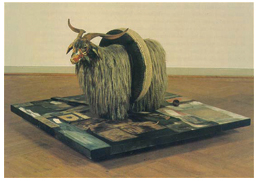| |
|

Robert Rauschenberg remembered
By Sharon Anderson
On Sunday, the 11th of May, I was visiting the new contemporary building that houses the Broad Collection at the Los Angeles County Museum of Art. While walking through the exhibit, I saw a girl around six years old sitting on a bench, quietly drawing the painting in front of her on her sketchpad. Canyon, a painting by Robert Rauschenberg, was the girl’s subject. The large canvas revealed ghostly photographic images beneath bold swatches of paint that hovered above a taxidermic bird perched on a box. Poised over her artist’s paper, the girls’ pencil made jagged marks like the teeth on a saw to represent feathers under the bird’s wings.
 Robert Rauschenberg’s Monogram, (1955-59), mixed mediums with Robert Rauschenberg’s Monogram, (1955-59), mixed mediums with
taxidermy goat, rubber tire and tennis ball, on wood platform mounted on four casters.
photo: courtesy of Moderna Museet, Stockholm
On Monday, the 12th of May, Robert Rauschenberg died at the age of 82. One of the most influential painters of the last century, Rauschenberg helped to define the eras of Abstract Expressionism and Pop Art with his fusion of imagery and found objects. He was best known for his “combine” paintings, works that featured objects found in and around his studio. Discarded wood, tires and pieces of metal combined to create works that were simultaneously paintings, sculptures, silkscreens, and collages. His most iconic image is the combine painting from 1955-59 known as Monogram, which features an Angora goat standing placidly on a painted square surface with a rubber tire around its middle, primary colors dappled on its muzzle.
As a young man, Rauschenberg discovered art during a visit to the Huntington Library Art Collections in San Marino, Calif. Immediately deciding to become an artist, he enrolled in several schools including Black Mountain College in North Carolina, where he began to create and meet other artists that were to influence his work, among them John Cage and Merce Cunningham. Like many Black Mountain artists, he began to explore the Dadaist principle of art as accident, allowing a random combination of images and media to create a visual narrative.
Throughout his career, Rauschenberg redefined more than just painting. He was a prolific printmaker, silkscreen artist, stage designer, photographer, lithographer and sculptor, all with the infectious enthusiasm and exploratory approach that defined his work. His creations are about process, not the end result. Ultimately, by implying a work in progress not yet completed, he invites us, the viewers, to become participants in his art. By reinventing spatial relationships between the natural and the man-made, Robert Rauschenberg imposed order on chaos. He gave us art to think about and to react against.
The process continues.
Sharon Anderson is an artist and writer in Southern California. She will be featured in the August 2008 issue of Art in America magazine.


|
|
|
|